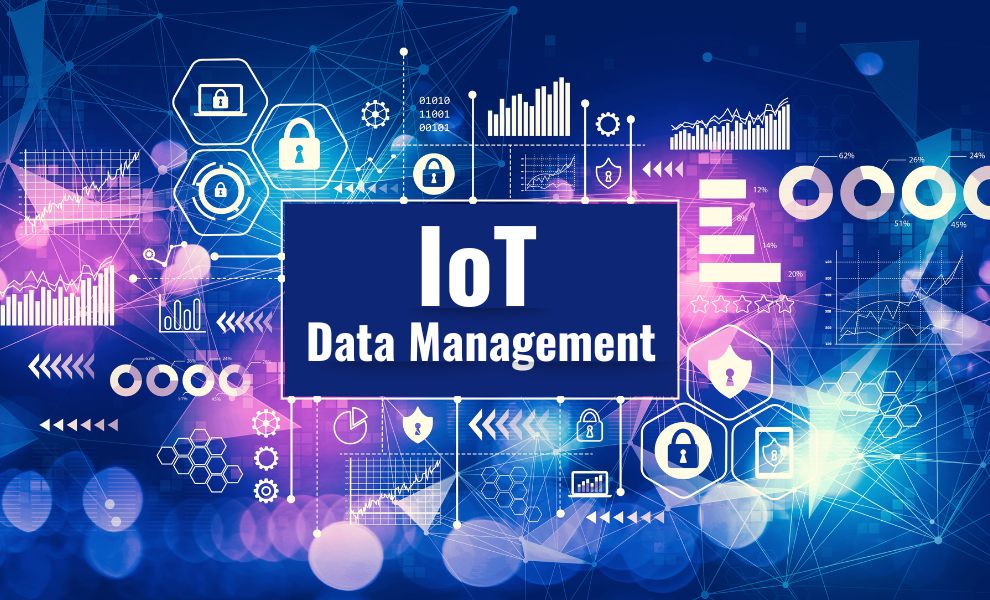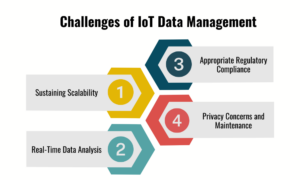The Internet of Things (IoT) has doubtlessly been a ladder toward smart living where humans and machines interact more effectively. With advanced techniques, IoT devices are now able to not only identify human concerns but also address them flawlessly. But how do devices attain such capability? By processing large amounts of data, often known as big data, and identifying patterns within the datasets. IoT data management plays a significant role in processing larger datasets.
Sources estimate that by the end of 2025, there will be more than 27 billion active IoT devices around the world. Such a number of devices is set to process over 80 zettabytes of data. But what if such an amount of data is not managed appropriately? IoT devices can be misled, contributing to faulty outcomes and deteriorated performance. Since IoT devices have become key components for industrial tasks, managing its data is also crucial for this sector while aiming for better outcomes.
Let us have an in-depth overview of IoT data management alongside its challenges and key strategies to manage IoT data constructively. Primarily, let us understand what IoT data is…
Understanding IoT Data:
IoT data is typically the vast amount of information that IoT devices collect and assess in order to operate smoothly. Such devices are often connected with each other through the internet, while receiving and sending data within them. IoT data allows such devices to understand what they are supposed to do and how to operate. In brief, we can say that without data, IoT devices cannot function appropriately and meet the expectations of the users.
Explaining IoT Data Management:
Since vast amounts of data enable IoT devices to operate, IoT data management ensures how to assess, control, and utilize these datasets. The data management process is typically adopted to analyze the raw data that IoT devices generate and extract actionable insights from it. These insights help IoT devices to operate, trace patterns, and accordingly make decisions. Generally, IoT devices collect and assess data automatically. However, data management involves an external intervention to control data usage while boosting the performance of such devices.
Effective data management for Internet of Things devices enables users and businesses to appropriately use such devices, ensuring efficiency and scalability. Firms usually adopt specific data management strategies for this purpose, which also allow them to eliminate the hurdles of IoT device functionality. IoT data management offers the following advantages-
- Operational Efficiency: Effective data management allows Internet of Things devices to trace instrumental insights from raw datasets. Such an approach helps devices to operate with significant efficiency.
- Advanced Decision Making: Data management enables real-time data analytics based on which IoT devices can make quick and efficient decisions.
- Customized Experiences: Data management can also contribute to product enhancement and the activation of customized experiences. During the extraction phase, data management helps add specifications to datasets according to which devices operate, incorporating customization.
Is Managing IoT Data Challenging?
Managing IoT data can impose several technical and non-technical challenges that need to be addressed for better performance. Let us discuss a few:
Sustaining Scalability: Since the number of connected devices and data they generate increases, the data management and storage systems also need to scale the information they are storing regularly. Therefore, integrating scalable systems has been a critical challenge that organizations often face in IoT data management.
Real-Time Data Analysis: IoT devices continuously generate unstructured data, analyzing the same in real-time, and retrieving insights can be challenging. Data quality also creates hurdles while analyzing data.
Appropriate Regulatory Compliance: Data generated and managed for IoT devices need to comply with the standard security benchmarks. However, ensuring compliance each time becomes difficult for businesses since they target the diverse needs of the audience.
Privacy Concerns and Maintenance: With the rise of cyber threats, IoT devices have become more vulnerable than ever to malicious intentions. Alongside that, regular maintenance of software and hardware can also be challenging while managing IoT data.
Robust Strategies to Manage IoT Data:
Integrate Edge and Cloud Computing
To tackle the challenge of storage and scalability, the integration of edge and cloud computing can be effective. Cloud computing offers flexible and scalable storage solutions. Alongside that, its vast storage options allow it to store and manage big data easily.
On the other hand, edge computing initiates data processing closer to the source, which can empower IoT data management with higher speed and limited latency. Additionally, with edge computing, IoT devices can process primary data filtering and analytics locally.
Initiate Advanced Analytics
Advanced analytics can help IoT devices overcome the challenges of appropriate real-time analytics, further contributing to effective operations and decision-making. In this regard, incorporating advanced analytics tools can be beneficial. Such tools include machine learning algorithms, which enable them to formulate prescriptive analytics, easily assess bigger datasets, and find patterns in them. Following such an analytics process, IoT devices can also make faster and more effective decisions.
Launch Continuous Monitoring and Data Governance
Having a continuous monitoring methodology helps businesses standardize their IoT data management tactics. It helps in identifying bigger to minor risks, allowing organizations to stay prepared for every situation. Moreover, adopting data governance strategies assists in keeping an eye on the data quality that has been integrated. It also allows us to assess regulatory compliance with the set security benchmarks.
Adopt Data Encryption and Authentication Techniques
Initiating encryption and authentication techniques can be highly beneficial to eliminating the security and compliance-centric issues of IoT data management. Such methods identify malicious activity easily, even when anyone processes the wrong authentication codes. It safeguards IoT data and contributes to the seamless operation of the devices.
Implementing IoT with advanced data management!
IoT and IIoT have redefined the connectivity spectrum with advanced communication between gadgets. However, managing these gadgets alongside the data they utilize is also essential. Any misconduct or errors can cause inappropriate performance. In some situations, devices may fail to meet their goals. Therefore, ensuring data quality, smooth operation, regulatory compliance, and data security is a must for successful IoT deployment.
Employing effective IoT data management strategies can offer enhanced opportunities for risk-free deployment of such technologies. The strategies we’ve mentioned above are also the Internet of Things best practices that allow businesses to optimize their process and sustain efficiency.
Explore the latest technologies and their best practices with our in-depth blogs!
Also Read:
How would IoT Benefits for Business?
AI Data Management – Beginner’s Guide
Top 7 Open-Source Master Data Management Tools



